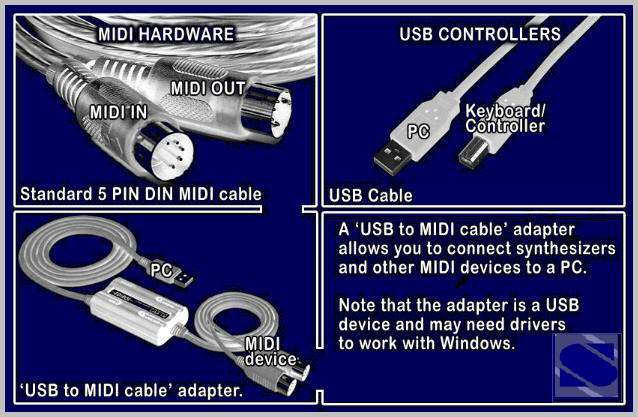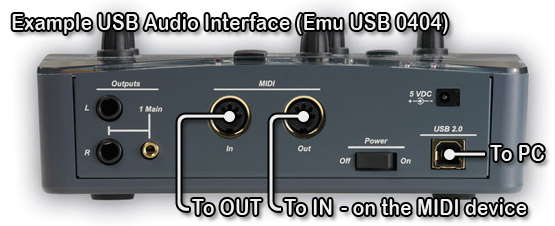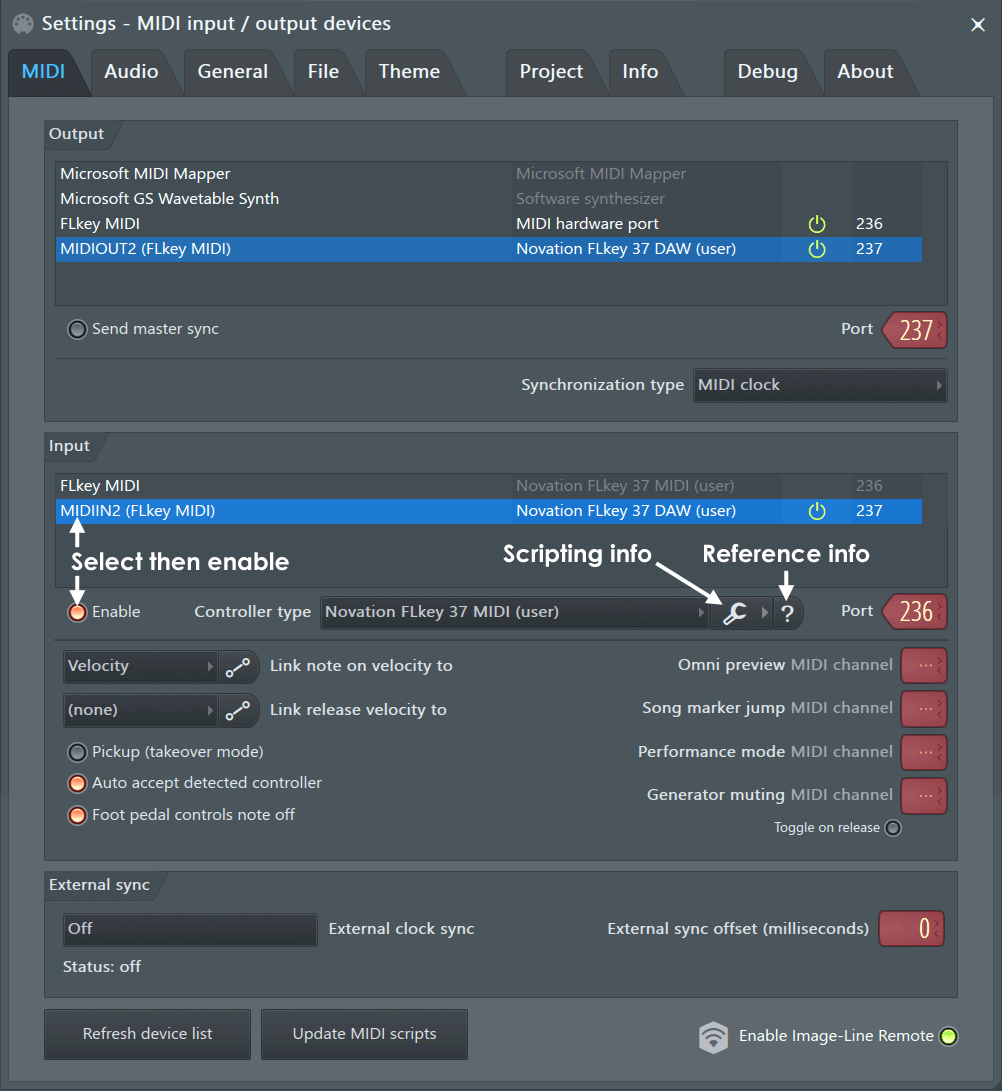|
|
| 
|
|
MIDI Setup
Connect and Install a MIDI
Keyboard / Synthesizer in Windows
(Example on FL Studio)
MIDI Setup
Select controllers
Click the MIDI tab
in the System
Settings window.
This section contains a list of software and hardware MIDI
devices on or connected to your system that can be used for
MIDI Input/Output. For example, hardware and software
synthesizers, controller keyboards and 'loopback' devices. The
most common
controllers used
by PC based musicians today connect to your PC with a USB
cable (rather than MIDI cable) and provide a piano-keyboard,
pad or mixer-style interface.

1. Connect and install
your keyboard/controller/synth in Windows
MIDI is not an audio connection -
The connections discussed on this page do not transfer audio,
MIDI connections transfer note data, knob movements and
program changes so that your controller can play software
instruments and/or FL Studio can play connected MIDI hardware.
To use sounds from an external synthesizer (while it is played
by FL Studio) you will need to make MIDI connections
(discussed here) AND audio
connections to
your soundcard inputs so that FL Studio can record
the sound/s that
it triggers from the external MIDI hardware using a MIDI
Out plugin.
Cable types -
You will either have a USB based keyboard/controller or
hardware with 5-pin DIN MIDI connectors.
-
USB connected
controller -
If your controller has
a USB port, then it will connect directly to your PC with a
standard USB
cable.
-
1. Install
any USB drivers that
came with your controller. Many controllers use the
standard Windows 'USB Audio Device (generic controller)',
see the Input list.
-
2. Connect
the controller to your PC, turn it on and follow the
Windows installation procedure. The standard USB 'connected ' process
should happen.
-
3. Start
FL Studio AFTER the controller driver has been installed and
proceed as described in the 'Setting input and output
MIDI devices' section below.
-
MIDI
cable connected controller -
If you have a device with 5-Pin
DIN connectors you
will probably need to purchase a USB
cable to MIDI cable adapter
as shown. Most external
audio interfaces have
MIDI connector plugs on them, use those if present.

-
1. Connect
the MIDI cables to
the MIDI IN and OUT ports on your MIDI interface hardware
and turn it on. Make
sure the
MIDI OUT on the interface is connected to the MIDI IN on
your MIDI device and or the MIDI IN on the device is
connected to the MIDI OUT on the MIDI interface. How
many MIDI cables do I need? You
need two MIDI cables if you want FL Studio to play your
MIDI device and to use your MIDI device to control FL
Studio. If you plan one-way communication, then you only
need one MIDI cable.
-
2. Install
any USB drivers that
came with your MIDI to USB adapter.
-
3. Plug
the MIDI adapter into your PC, turn it on and follow
the Windows installation procedure. The standard USB 'connected ' process
should happen.
-
4. Start
FL Studio AFTER the adapter driver has been installed and
proceed as described in the 'Setting input and output
MIDI devices' section below.
2. Set input and output MIDI devices
You may want to select an Input (a
controller that plays FL Studio instruments) or Output device
(something that connects to your PC and receives note data
from FL Studio).

Output - Port Mapping
These options select a MIDI
output interface so
FL Studio can send MIDI signals to outboard gear (Synthesizer,
Drum Machine, Sampler, etc). See the MIDI
Settings page
for more details.
Input - Connecting External Controller/s
If you have a USB/MIDI
keyboard or controller that
you would like to control using FL Studio, you will need to
change some settings in the Input section.
This contains a list of controller devices that have been
detected by Windows (see section 1).
To activate a controller in FL Studio -
-
Open FL Studio and
make sure the 'Enable MIDI remote control' option is
selected in the Options
menu, MIDI input is
disabled otherwise.
-
Click on
the device in
the Input list, so that it is highlighted. If your device is
listed in the Controller
type drop-down
menu, select it there also. If your controller does not
appear by name this means it does not have custom drivers.
If so, use the 'USB Audio Device (generic controller)'.
If you do not see any options, you will need to re/install
the appropriate drivers for your controller.
-
With the
controller highlighted select the Enable switch
below the Input list. Each device selected in the Input list
must be selected/deselected separately.
-
If
successful the MIDI activity light on the Main
Panel will
blink each time you play notes or move knobs on your
controller. NOTE: If
the 'Debug
log' is open any MIDI
data received
by FL Studio is
displayed and logged, useful for learning the MIDI CC
numbers of controls or troubleshooting connections.
NOTE: For
more detailed information on the rest of the settings in this
section and further details on supported controllers go to the MIDI
Settings page.
Troubleshooting
-
Nothing appears
in the Input box? -
Did you connect/start your controller AFTER opening FL
Studio? It is necessary that your operating system has
detected your controller BEFORE opening FL Studio. Close FL
Studio, turn your controller off and on (unplug and
reconnect the USB cable if it does not have a switch), wait
for it to be detected by the PC (Windows makes a 'connected' sound
when it successfully detects a USB device), then start FL
Studio.
-
Items
appear but don't respond -
Click the Rescan
MIDI devices button
and then enable the
device. If that does not work, close FL Studio, turn your
controller off and on (unplug and reconnect the USB cable if
it does not have a switch), wait for it to be detected by
the PC (Windows makes a 'connected' sound
when it successfully detects a USB device), then start FL
Studio.
Velocity curve
If you are using a MIDI Keyboard or Pad Controller then click
on the Link note
on to: Velocity Curve button.
Here you can fine-tune the relationship between MIDI input
velocity (how fast/hard you strike the keys/pad) and the
velocity
value sent to instruments.
See also:
Interfaces, Keyboards and Controllers

MIDI is a
trademark of MIDI Manufacturers Association Incorporated.
About MIDI -
Making Music with MIDI
- MIDI Controllers -
MIDI Products -
MIDI Glossary -
MIDI Polyphonic
Expression (MPE)
|
| |
|

